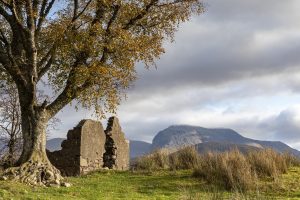Since 2021, photographer and historical researcher Estelle Slegers Helsen has been wandering around Lochaber in the footsteps of the Scottish photographer W.S. Thomson MBE (1906-1967). She takes photographic remakes roughly 70 years after Thomson initially captured the landscape and talks to local people along her journey. Every fortnight, Estelle takes our readers to various places in Lochaber. This week, she focuses on Tombuie, an abandoned cottage above Corpach.

In the early 1950s, W.S. Thomson took the photograph Winter sun and hoar frost
above Corpach, Ben Nevis in the distance, which was published in his pictorial
book Colourful Scotland (1956).
He already lived in Corpach, settling in Kilmallie House in 1951 after having lived on Cameron Square in Fort William for six years.
Being familiar with the location, he probably ran up to Tombuie knowing the hoar
frost was perfect for an outstanding photograph.
Hoar frost is a godsend for photographers. This meteorological phenomenon creates a magical world of objects covered with crystal-clear ice against a bright blue sky.
The winter wonderland continues for as long as the temperature remains well below zero.
It was at the end of October 2021, and this image was the first in a series of remakes taken over the next few years in Lochaber.
I only had a vague idea of where to go and parked my car on Drumfada Terrace. This was a challenge as I was still learning the technique of retracing places.
New to the area and with only a scattering of preliminary research, it was like looking for a needle in a haystack.
I scrambled for more than an hour in the fields above the cemetery and the surrounding area, ending up in a muddy field near the back garden of a house.
The owner, who was creating a ditch with an oversized digger on an adjacent
track, looked surprised and asked where I came from.
Luckily, this is Scotland. In England people would not be amused. I apologised and explained the purpose of my journey.
While both looking at the satellite map on my phone we discovered a vague outline of a long-abandoned cottage. It could be the one I was looking for.
We then discussed how I might reach the location.
About an hour later I found a ruin. It was Tombuie with the birch tree still there
70 years later.
Overexcited, I took a few remakes but the light wasn’t great. I packed my gear and decided to return in a few days.
On my way down, I said hello to a man on a quad bike inspecting Shetland sheep.
In the evening I posted the then-and-now photographs on the Fort William Memories
Facebook page, and Jean Sneddon contacted me the next day.
“I am so sad to see the gable end has come down. It is many years since I was up
there as I’m not as able anymore,” said Jean.
“My grandfather Dugald Macintyre was the local shepherd and lived in Tombuie until the late 1950s when he moved to one of the new houses on Drumfada Road.”
Sometimes, social media is a handy tool.
The face of Corpach changed rapidly in the 1950s and 60s because of the development of a paper mill, which, at its peak in the 1970s, employed over 900 people.
Corpach, A’ Chorpaich in Gaelic, means “field of the death” and is thought to originate from it being a resting place on the coffin road used to carry chieftains for burial on Iona.
Jean continues: “I am sure W.S. Thomson photographed my grandfather while herding a couple of cows up the hill at Corpach, just above Kilmallie Parish Church.
“My parents had it framed and it hung in their living room. It is lost now and I have been looking for it ever since.”
Over the next few days, as I ask about the landowner, I am referred to Maisie MacPhee, who welcomed me to her house opposite the land leading to Tombuie.
Her husband, John, who joins the conversation, recognises me from a week ago when I was walking down the hill.
“I was the man on the quad bike,” he says, smiling.
Maisie has many stories but doesn’t remember Dugald Macintyre living in Tombuie.
“I was about three years old when he moved to Drumfada Terrace.
“I remember visiting the place; it was empty but still had a roof. The building was deteriorating fairly quickly and vandalism had its part to play.”
I conclude my first 10-day journey in early November 2021, in the Fort William area, with another remake at Tombuie.
The path, shown on a late 19th-century Ordnance Survey map, starting from the main road opposite Corpach Hotel, has long disappeared. Houses have been built on much of the land.
Instead, I take the gates from the main road opposite Maisie’s house. Their Shetland sheep follow me as I ramble uphill.
In Thomson’s old photograph, chickens are part of the scenery. I hope to include some sheep in my remake.
But by the time my camera is in place and the light is good, the sheep have lost interest and are nibbling grass further away.
At least the birch tree is still there. If that tree could talk, I would have the whole story…
In 2022, Jean messaged me the photograph of her grandfather herding two cows on the
hill with Corpach and Loch Linnhe in the background.
- Travel in Time – Lochaber Series was supported by the West Highland
Museum and the Year of Stories 2022 Community Fund. Estelle has published a
64-page book with 30 side-by-side then-and-now pictures, which you can find
in local shops or buy online – www.travelintime.uk